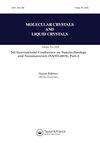TPD和PBD薄膜发光器件的光学特性
Molecular Crystals and Liquid Crystals Science and Technology. Section A. Molecular Crystals and Liquid Crystals
Pub Date : 2001-10-01
DOI:10.1080/10587250108024775
引用次数: 0
摘要
摘要研究了CuPC(酞菁铜)/ TPD (N,N′-二苯基-N,N′-二(间甲基苯基)-联苯胺)/ PBD(2-(4-联苯基)-5(4-叔丁基苯基)-1,3,4-恶二唑)的电致发光(EL)器件的发射光谱。EL器件发出的蓝光有两个发射最大值,其中一个距离光致发光最大值约50 nm的深色偏移[2]。这种色移是在高电场作用下产生的新能态引起的[1]。本文章由计算机程序翻译,如有差异,请以英文原文为准。
The Optical Characteristics of the Light Emitting Device with TPD and PBD Thin Films
Abstract The emission spectra generated from the electroluminescence (EL) devices on CuPC (copper phthalocyanine) / TPD (N,N′-diphenyl-N,N′-di(m-tolyl)-benzidine) / PBD (2-(4-biphenylyl)-5(4-tert-butyl-phenyl)-1,3,4-oxadiazole) had been studied. The EL devices emitted blue light two emission maxima, and one of them is about 50 nm bathochromic shifted from the photoluminescence maximum [2]. The bathochromic shift is caused by the new energy state generated under a high electric field [1].
求助全文
通过发布文献求助,成功后即可免费获取论文全文。
去求助
来源期刊
自引率
0.00%
发文量
0

 求助内容:
求助内容: 应助结果提醒方式:
应助结果提醒方式:


